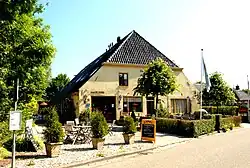Westernieland
Westernieland (Gronings: Westernijland) is a village in the Dutch province of Groningen. It is part of the municipality of Het Hogeland. The village is located near the Wadden Sea.
Westernieland | |
|---|---|
 De Oude Smidse in Westernieland | |
 Westernieland Location in province of Groningen in the Netherlands  Westernieland Westernieland (Netherlands) | |
| Coordinates: 53.4002°N 6.4808°E | |
| Country | Netherlands |
| Province | Groningen |
| Municipality | Het Hogeland |
| Area | |
| • Total | 0.88 km2 (0.34 sq mi) |
| Elevation | 1 m (3 ft) |
| Population (2021)[1] | |
| • Total | 230 |
| • Density | 260/km2 (680/sq mi) |
| Time zone | UTC+1 (CET) |
| • Summer (DST) | UTC+2 (CEST) |
| Postal code | 9969 |
| Dialing code | 0595 |
History
Around 1000, the village of Mariaburen was founded on a sand ridge near the Wadden Sea.[3] Westernieland was sometimes referred to as Mariaburen in den Nijenlanden (Mariaburen in the new lands),[4] however it is unclear whether it is the same village. Around 1350, a dike was built.[3] The village was first mentioned in 1406 as Inden Nyen Lande (in the new land). Later "west" was added to distinguish itself from Oosternieland to the east.[5] The church contains 14th century parts, however the main construction is from 1831.[6]
Due to the proximity to the Wadden Sea, the village was flooded several times.[7] The worst flood was the Christmas Flood of 1717 when only four of the 50 houses were still habitable, and 78 people died.[4] The church remained standing, but contained two metres of water.[3] Westernieland was rebuilt on higher ground which explains the detached location of the church.[4] In 1795, it became part of the municipality of Pieterburen.[8] In 1840, the population was 500 people.[7]
Even though Pieterburen, the main village, is nowadays known for the Seal Rehabilitation and Research Centre, the economy was partially based on seal clubbing.[7] The last sealer in the Netherlands was Ko Teerling from Westernieland.[3] During his best season, he had killed 600 seals. Later limits were imposed, and it was declared illegal in 1957.[9]
In 1939, an unemployed camp was constructed near the village for a poldering project. From 1945 to 1947, it served as an internment camp for members of the NSB (Dutch Nazi party).[6] Up to the 1970s, Westernieland was a lively community with shops. Since then, it has lost its retail and the school has closed down.[7] In 2019, it became part of the municipality of Het Hogeland.[7]
Westernieland is one of the starting points for wadlopen (mudflat hiking). At low tide, it is possible to walk to the island of Schiermonnikoog.[10] Mudflat hiking is potentially dangerous, and is only allowed under the supervision of a licensed guide.[11]
Notable people
- Freek de Jonge (born 1944), cabaret performer and writer[12]
Gallery
 Church of Westernieland
Church of Westernieland Bar in Westernieland
Bar in Westernieland The barracks of the unemployed camp
The barracks of the unemployed camp_(2775287644).jpg.webp) Mudflat hiking near Westernieland
Mudflat hiking near Westernieland
References
- "Kerncijfers wijken en buurten 2021". Central Bureau of Statistics. Retrieved 8 March 2022.
Westernieland + Kaakhorn
- "Postcodetool for 9969PA". Actueel Hoogtebestand Nederland (in Dutch). Het Waterschapshuis. Retrieved 8 March 2022.
- Emmy Wagenaar Hummelinck. "Robbenjagers en monnikenwerk in Westernieland". De Verhalen van Groningen (in Dutch). Retrieved 8 March 2022.
- "Kerk Westernieland". Protestants Community Winsum-Halfambt (in Dutch). Retrieved 8 March 2022.
- "Westernieland - (geografische naam)". Etymologiebank (in Dutch). Retrieved 8 March 2022.
- Redmer Alma (1998). Pieterburen (in Dutch). Zwolle: Waanders Uitgevers. p. 186. ISBN 90 400 9258 3. Retrieved 8 March 2022.
- "Westernieland". Plaatsengids (in Dutch). Retrieved 8 March 2022.
- "Bekendmaking". Ommelander courant (in Dutch). 2 August 1796. Retrieved 8 March 2022.
- "Mee op robbenjacht (interview with Ko Teerling)". Nieuwsblad van het Noorden (in Dutch). 12 March 1983. Retrieved 8 March 2022.
- "Pieterburenwad zwerftocht". Wadlopen met Wim Spijk (in Dutch). Retrieved 8 March 2022.
- "Verordening van 13 december 1995, houdende regels met betrekking tot het wadlopen (Wadloopverordening 1996)" [1996 law for mudflat hiking] (PDF). Waddenzee (in Dutch). 13 December 1995. Retrieved 8 March 2022.
- "Profiel: Freek de Jonge". De Groene Amsterdammer (in Dutch). 1 March 2000. Retrieved 8 March 2022.